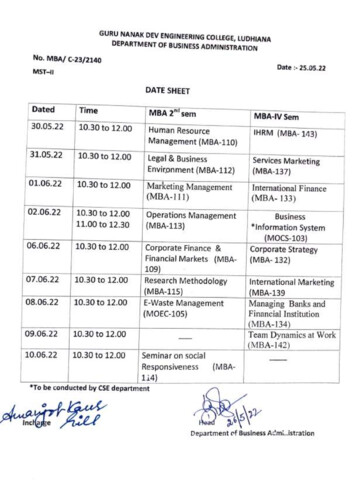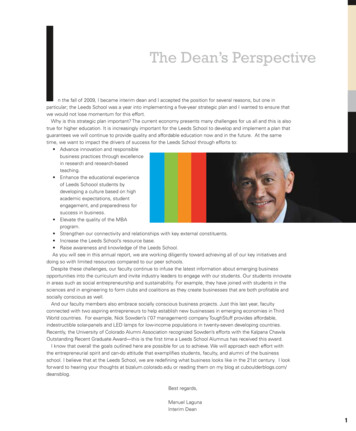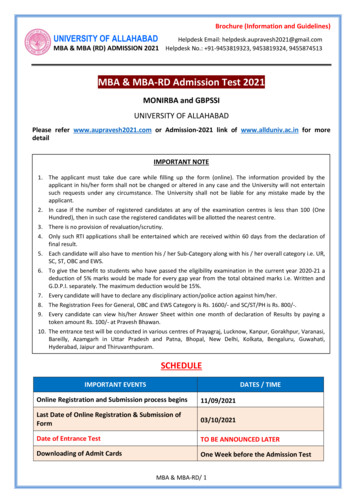
Transcription
Class of 2020 Professional MBAEmployment Profile Report
Executive SummaryThe Career Development Office is pleased to present theClass of 2020 Professional MBA Employment ProfileReport. This report was developed using the MBA CSEAStandards for Reporting Part-time Employment Profile.In spite of a global pandemic and a challenging oil & gasjob market, our Professional MBA graduates demonstratedresiliency and fortitude in their job search. Graduatesaccepted positions within a wide range of industries andjob functions, including many who pivoted their careersinto new job levels and companies. I am thankful to theRice Business community of faculty, staff, alumni, andstudents for coming together to support our ProfessionalMBA graduates in realizing their career goals.Go Owls!Philip Heavilin II, Executive DirectorCareer Development OfficeKey Highlights: 43% of the class provided their employment statusTop 3 industries include: Energy (31.3%),Consulting (22.4%), Financial Services (14.9%)Top 3 functions include: Consulting and Finance(both at 24.5%), Marketing/Sales (11.9%)89.2% accepted positions in the SouthwestAverage base salary: 132,419Average signing bonus: 25,96748% accepted positions from school-facilitatedactivities24% continued with their current employer, eitherin new roles or keeping same role20.9% changed companies61.2% changed level of position9% changed industries
Accounting For All Part-Time Graduates By ProgramDeliveryEmployedStarted / Starting Own BusinessUnemployedNo Recent InformationLeft the d000000Total6701501195Notes1. Only includes data for outcomes collected within 5 months of the student's graduation date.2. "Employed" graduates includes students who reported any of the following outcome types: Accepted Offer, Sponsored Job, Continuing Current Job, Staying in Current Role, Returning to FamilyBusiness. Depending on how your site is configured, some of these outcome types may not be enabled.3. "Started / Starting Own Business" graduates include students who reported an "Own Venture" outcome type.4. "Unemployed" graduates include students who reported a "Seeking Employment (Unemployed)" outcome type.5. "No Recent Information" include students who have a "No Recent Information Available" outcome type.6. "Left the Workforce" includes students who reported reported any of the following outcome types: Continuing Education, Postponing Job Search, Not Seeking (Other Reasons), Taking time off (morethan 4 months), Caring for or starting a home or family. Depending on how your site is configured, some of these outcome types may not be enabled.7. Students can appear in the "Excluded" warning message if one or more of the following criteria are true: 1) Accepted offer with no accepted date or accepted date greater than 4 months aftergraduation 2) "Reported Date" is greater than 5 months after graduation 3) Student has no reported outcome.
Employment By IndustriesIndustryConsultingConsumer Packaged GoodsFinancial ServicesHealthcare (Including Products l ReportingEmployed .0%6.0%31.3%9.0%4.5%100%Mean Base Salary Median Base Salary Low Base SalaryHigh Base Salary 132,333I/D 140,800 135,000I/D 150,000 90,000I/D 70,000 160,000I/D 175,000 107,083 120,000 145,200 128,231 95,000 132,419 91,500 122,500 140,000 122,500 100,000 130,000 87,000 100,000 95,200 114,386 85,000 70,000 165,000 135,000 238,000 165,000 100,000 238,000Notes1. Only includes data for outcomes collected within 5 months of the student's graduation date.2. Only includes data for accepted jobs within 4 months of the student's graduation date.3. Compensation statistics do not include values where the student entered 0 or did not respond.4. The percentage of students for whom there is usable salary information is 100%. (This calculation is made by dividing the number of employed graduates for whom you have useable salaryinformation/total employed graduates).5. "Employed Graduates" includes students who reported any of the following outcome types: Accepted Offer, Sponsored Job, Continuing Current Job, Staying in Current Role, Returning to FamilyBusiness. Depending on how your site is configured, some of these outcome types may not be enabled.6. I/D refers to instances with insufficient data. MBA Standard guidelines require a minimum of three data points for each category and that the number of data points is equal to or greater thanone percent of full-time graduates seeking employment. Data points not meeting both requirements will still display the number of employed graduates, but will show "I/D" for all salarycalculations.7. Employed graduates without known salary information are included in the leftmost 'Employed Graduates' columns, but are not included in the salary calculations.8. Employed graduates without known Industry are excluded from the table, and will appear in the "Excluded" warning message.
Employment By Professional FunctionsFunctionConsultingFinanceGeneral ManagementHuman ResourcesMarketing/SalesInformation TechnologyOperations/LogisticsOtherTotal ReportingEmployed 9%11.5%69.0%1116.4%67100%Mean Base SalaryMedian Base SalaryLow Base SalaryHigh Base Salary 132,353 132,941 122,000I/D 120,923I/D 122,083 151,564 132,419 135,000 142,000 120,000I/D 117,193I/D 122,500 140,000 130,000 90,000 70,000 87,000I/D 100,000I/D 85,000 90,000 70,000 182,000 180,000 165,000I/D 160,000I/D 165,000 238,000 238,000Notes1. Only includes data for outcomes collected within 5 months of the student's graduation date.2. Only includes data for accepted jobs within 4 months of the student's graduation date.3. Compensation statistics do not include values where the student entered 0 or did not respond.4. The percentage of students for whom there is usable salary information is 100%. (This calculation is made by dividing the number of employed graduates for whom you have useable salaryinformation/total employed graduates).5. "Employed Graduates" includes students who reported any of the following outcome types: Accepted Offer, Sponsored Job, Continuing Current Job, Staying in Current Role, Returning to FamilyBusiness. Depending on how your site is configured, some of these outcome types may not be enabled.6. I/D refers to instances with insufficient data. MBA Standard guidelines require a minimum of three data points for each category and that the number of data points is equal to or greater thanone percent of full-time graduates seeking employment. Data points not meeting both requirements will still display the number of employed graduates, but will show "I/D" for all salarycalculations.7. Employed graduates without known salary information are included in the leftmost 'Employed Graduates' columns, but are not included in the salary calculations.8. Employed graduates withoutknown Function are excluded from the table, and will appear in the "Excluded" warning message.
World Region BreakdownRegionAfricaAsiaEuropeLatin America & the CaribbeanNorth AmericaOceaniaTotal ReportingEmployed ean Base SalaryMedian Base SalaryLow Base SalaryHigh Base SalaryI/DI/DI/DI/D 132,417I/D 132,417I/DI/DI/DI/D 130,000I/D 130,000I/DI/DI/DI/D 70,000I/D 70,000I/DI/DI/DI/D 238,000I/D 238,000Notes1. Only includes data for outcomes collected within 5 months of the student's graduation date.2. Only includes data for accepted jobs within 4 months of the student's graduation date.3. Compensation statistics do not include values where the student entered 0 or did not respond.4. The percentage of students for whom there is usable salary information is 100%. (This calculation is made by dividing the number of employed graduates for whom you have useable salaryinformation/total employed graduates).5. "Employed Graduates" includes students who reported any of the following outcome types: Accepted Offer, Sponsored Job, Continuing Current Job, Staying in Current Role, Returning to FamilyBusiness. Depending on how your site is configured, some of these outcome types may not be enabled.6. I/D refers to instances with insufficient data. MBA Standard guidelines require a minimum of three data points for each category and that the number of data points is equal to or greater thanone percent of full-time graduates seeking employment. Data points not meeting both requirements will still display the number of employed graduates, but will show "I/D" for all salarycalculations.7. Employed graduates without known salary information are included in the leftmost 'Employed Graduates' columns, but are not included in the salary calculations.8. Employed graduates without known Region are excluded from the table, and will appear in the "Excluded" warning message.
Compensation by Region: North AmericaNorth American Sub-regionsUnited estTotal North AmericaEmployed 0%100%Mean Base SalaryMedian Base SalaryLow Base SalaryHigh Base Salary 133,333I/DI/D 116,667 133,484I/D 132,417 130,000I/DI/D 115,000 135,000I/D 130,000 120,000I/DI/D 110,000 70,000I/D 70,000 150,000I/DI/D 125,000 238,000I/D 238,000Notes1. Only includes data for outcomes collected within 5 months of the student's graduation date.2. Only includes data for accepted jobs within 4 months of the student's graduation date.3. Compensation statistics do not include values where the student entered 0 or did not respond.4. The percentage of students for whom there is usable salary information is 100%. (This calculation is made by dividing the number of employed graduates for whom you have useable salaryinformation/total employed graduates).5. "Employed Graduates" includes students who reported any of the following outcome types: Accepted Offer, Sponsored Job, Continuing Current Job, Staying in Current Role, Returning to FamilyBusiness. Depending on how your site is configured, some of these outcome types may not be enabled.6. I/D refers to instances with insufficient data. MBA Standard guidelines require a minimum of three data points for each category and that the number of data points is equal to or greater thanone percent of full-time graduates seeking employment. Data points not meeting both requirements will still display the number of employed graduates, but will show "I/D" for all salarycalculations.7. Employed graduates without known salary information are included in the leftmost 'Employed Graduates' columns, but are not included in the salary calculations.8. Employed graduates without known North American Sub-regions are excluded from the table, and will appear in the "Excluded" warning message.
Employment by Professional ExperienceYears of Professional Experience0-3 years4-7 years8-12 years13-20 yearsOver 20 yearsEmployed ean Base SalaryMedian Base SalaryLow Base SalaryHigh Base Salary 129,795 122,963 137,280 186,750I/D 125,000 120,000 140,000 181,000I/D 114,386 70,000 85,000 165,000I/D 150,000 190,000 238,000 220,000I/DNotes1. Only includes data for outcomes collected within 5 months of the student's graduation date.2. Only includes data for accepted jobs within 4 months of the student's graduation date.3. Compensation statistics do not include values where the student entered 0 or did not respond.4. The percentage of students for whom there is usable salary information is 100%. (This calculation is made by dividing the number of employed graduates for whom you have useable salaryinformation/total employed graduates).5. "Employed Graduates" includes students who reported any of the following outcome types: Accepted Offer, Sponsored Job, Continuing Current Job, Staying in Current Role, Returning to FamilyBusiness. Depending on how your site is configured, some of these outcome types may not be enabled.6. I/D refers to instances with insufficient data. MBA Standard guidelines require a minimum of three data points for each category and that the number of data points is equal to or greater thanone percent of full-time graduates seeking employment. Data points not meeting both requirements will still display the number of employed graduates, but will show "I/D" for all salarycalculations.7. Employed graduates without known salary information are included in the leftmost 'Employed Graduates' columns, but are not included in the salary calculations.8. Employed graduates without known Years of Professional Experience are excluded from the table, and will appear in the "Excluded" warning message.
Compensation ReportBase SalaryNumber Reporting Base SalaryInformationTotal Reporting Base Salary67(1) Divides number of students reporting Base Salary by the number ofstudents reporting accepting a position.Signing/Starting BonusPercent Reporting Base Salary(1)Information100%Number Reporting Signing/Starting Percent Reporting Signing/StartingBonus InformationBonus(2) InformationTotal Reporting Signing/StartingBonus2841.8%(2) Divides number of students reporting useable Signing/Starting Bonus information by the number ofstudents providing base salary information.Mean 132,419Median 130,000Low 70,000High 238,000MeanMedianLowHigh 25,967 23,750 5,000 60,000Notes1. Only includes data for outcomes collected within 5 months of the student's graduation date.2. Only includes data for accepted jobs within 4 months of the student's graduation date.3. Compensation statistics do not include values where the student entered 0 or did not respond.4. The percentage of students for whom there is usable salary information is 100%. (This calculation is made by dividing the number of employed graduates for whom you have useable salaryinformation/total employed graduates).
Primary Source of Current/Accepted PositionSchool Related / Alumni NetworkCurrent / Former EmployerExecutive Search Firm / HeadhunterSchool Posting/Recruiting ActivityGraduate's Own NetworkExternal Job 00Hybrid00000000Total516227125067Notes1. Only includes data for outcomes collected within 5 months of the student's graduation date.2. Only includes data for accepted jobs within 4 months of the student's graduation date.3. Employed graduates without known Primary Source of Current/Accepted Position are excluded from the table, and will appear in the "Excluded“warning message.
Classifying Employment onNumber Reporting ChangePercent Reporting Change1420.9%4161.2%811.9%69.0%46.0%Notes1. Only includes data for outcomes collected within 5 months of the student's graduation date.2. Only includes data for accepted jobs within 4 months of the student's graduation date.3. Graduates are included in this table by comparing their job reported in the "Job at start of program" job phase to a qualifying post graduation outcome (see criteria for "Employed" category onTable 1).
Job Change by IndustryIndustryConsultingConsumer Packaged GoodsEnergyFinancial ServicesHealthcare (Including Products and Services)ManufacturingOtherTechnologyStart of 14.3%28.7%Four Month Post 0%34.5%69.0%Notes1. Only includes data for outcomes collected within 5 months of the student's graduation date.2. Only includes data for accepted jobs within 4 months of the student's graduation date.3. Graduates are included in this table by comparing their job reported in the "Job at start of program" job phase to a qualifying post graduation outcome (see criteria for"Employed" category on Table 1).
Job Change by l ManagementHuman ResourcesInformation Start of .7%626.1%Four Month Post %69.0%1116.4%Notes1. Only includes data for outcomes collected within 5 months of the student's graduation date.2. Only includes data for accepted jobs within 4 months of the student's graduation date.3. Graduates are included in this table by comparing their job reported in the "Job at start of program" job phase to a qualifying post graduationoutcome (see criteria for "Employed" category on Table 1).
Class of 2020 Professional MBA Employment Profile Report. This report was developed using the MBA CSEA Standards for Reporting Part-time Employment Profile. In spite of a global pandemic and a challenging oil & gas job market, our Professional MBA graduates demonstrated resiliency and fortitude in their job search. Graduates










